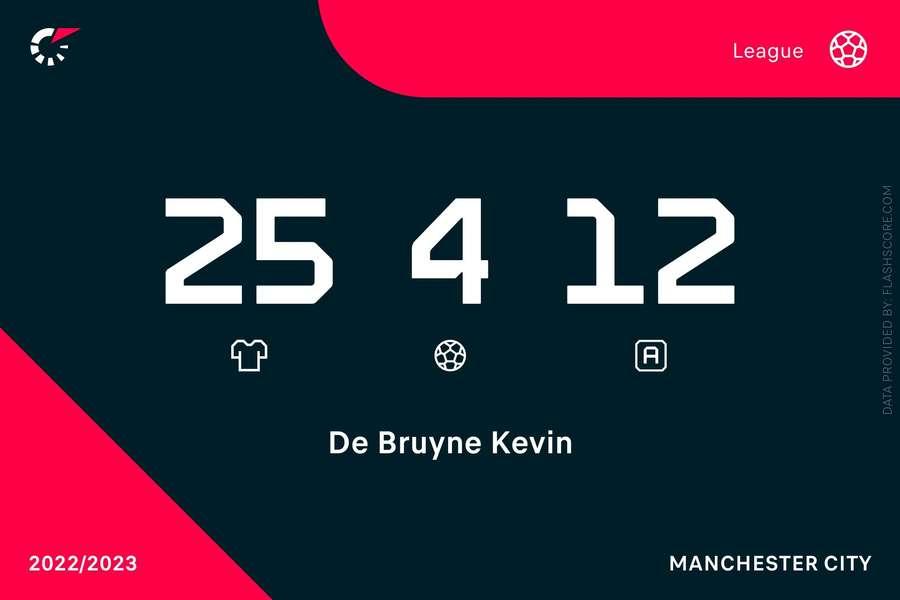Any football fan will know that assists come in all shapes and sizes. There’s Kevin De Bruyne’s (31) quarterback-style ball from the pocket onto the head of part-man, part-monster Erling Haaland (22). Then there’s Andrew Robertson (29) whipping in a wicked cross from the left for Liverpool and then there’s the Olivier Giroud (36) knock-down into the path of his strike partner - right place, right time.
They are all substantially different passes, in different passages of play, and yet they are all exactly the same because, so long as a goal is then scored, they all count as an assist. And that assist is then notched onto the charts all over the web, including on Flashscore.com, and then etched into our collective football memories as a statistical truth.
Goals and assists - that’s how we generally quantify the value of attacking players in professional football and that’s how we remember their performances over time. Harry Kane (29) in the 2021/22 Premier League: 17 goals and nine assists - a campaign to remember.
But just by imagining those three diverse examples above, two key issues with the statistic of assists come immediately to light. Firstly, they only count if the assisted player scores and, secondly, they only count if they are the final pass in a scoring sequence.
What about all those missed chances?
To the first point - the problem is that no matter how delicious or delicate a through-ball is, however perfectly curved a first-time cross may be, it is only an assist if the player receiving that pass then scores a goal. This is understandable. We don’t care about all the assists that could have been but maybe we should care about all the assists that should have been.
This is where Expected Assists (xA) comes to the rescue. xA is the little brother of the now widely used Expected Goals (xG), which is now displayed in the match stats on Flashscore.com. You can read all about it here.
For those who don’t quite understand xG yet - in short, it tells us how many goals a certain team or player was expected to score based on the quality and number of shots taken.
There are different models for determining xG but the basic idea is the same. For every shot, there is a probability of that shot resulting in a goal based on the historical occurrences of similar shots from similar positions. According to this data, each shot is given a value between zero and one which represents the likelihood of that shot resulting in a goal. The closer that value gets to one, the more the player shooting should have scored.
For example, a shot with an xG rating of 0.1 means your average footballer would score from that position one in every 10 attempts. A shot from one yard out from the goal line might have an xG closer to 0.9, however, meaning it should be scored 90% of the time. xG has quickly become a part of the common parlance of football. Rather than just looking at shots, we now look at and talk about xG readily.
Earlier this month, Liverpool lost 1-0 to Bournemouth but their xG was higher. In fact, Liverpool ended the match with an xG of 1.89 to Bournemouth’s 0.97. This means that although Bournemouth were good value for one goal, Liverpool should have scored once or twice based on the chances they had. They shouldn’t have lost - and we now have a neat way of showing this statistically.
xA follows from xG. In the same way as shots, each pass is given a numerical value between zero and one that grades the likelihood of it leading to a goal. The xA of a pass is equal to the xG of the shot that pass led to. Take all of a player’s passes and add up the xG of the shots their passes directly led to and you've got their xA for the match or for the season.
Kevin and I and why xA matters
How is xA useful? Well, xA allows us to take the success of a shot out of the equation when evaluating the quality of the previous pass. Let’s say De Bruyne wasn’t playing with Haaland but rather with someone far inferior. Let’s say, for example, with a regular guy like me.
I play football but at a very low level and whatever little magic I once possessed is rapidly leaving me. What's more, I am also a pretty terrible striker, having barely played the position at all. So, imagine me running around and trying to latch onto De Bruyne’s lofted passes at the Etihad Stadium. I probably wouldn’t score any goals for Manchester City and so he'd have far fewer assists to his name.
So far this season, De Bruyne has 12 assists in the Premier League - the most of any player in the league and the second-most in the 'top five' European leagues (behind only Lionel Messi). Six of those are assists directly for Haaland.

If it were me in Haaland’s enormous boots, well, De Bruyne would have precisely six fewer assists this season and his value according to this metric would be completely undermined.
xA allows us to assign value to De Bruyne’s passing ability despite me being a terrible striker and completely out of my depth in a professional football environment. He’d still have six fewer assists if I had been playing but his xA would remain the same because I still should have scored those six goals.
Looking at xA stats for this Premier League season (according to understat.com), it turns out that De Bruyne’s xA is almost exactly the same as his actual assists. He has the highest xA in the league at 12.36 - meaning he should have about 12 assists, which he does because he’s playing with, arguably, the best striker in the world, amongst others.
Manchester United’s Bruno Fernandes (28) is second on the list with an xA of 10.64 but he only has six actual assists. This means his strikers are underperforming because he should have almost twice as many assists as he does.

What about the penultimate pass?
What about that other issue I hinted at above? Assists only count - in fact, assists only exist - if they are the final pass in a sequence that leads to a goal. It doesn’t matter if De Bruyne’s ball is the decisive pass if Haaland then knocks it down to an onrushing Ilkay Gundogan (32) to score, then Haaland gets the assist and De Bruyne gets nothing - statistically speaking at least.
This is where the lesser-referenced Key Passes and Chances Created statistics come into play. Key Passes count the so-called key pass in sequence, be it final, second-last or other, and Chances Created combines those with assists. These are useful tools but the problem with these stats is that they are more qualitative in essence - which pass is the key pass and who decides that it is?
We don’t have objective metrics to draw on for penultimate (second-last) passes or antepenultimate (third-last) passes in goal-scoring sequences and we probably wouldn’t want those either because it would all get a bit too bloated and arcane.
We don’t want to compare sets of final, penultimate, or antepenultimate passes - we want to compare all passes, quantify them somehow and find out who is the best player. This is where the natural complexity of football gets in the way of us neatly wrapping it all up in a nice numerical bow.
Football isn’t like baseball or cricket where value can be assigned easily to many aspects of play. It’s a lot more fluid and chaotic and set plays are few and far between. Free kicks, penalties and corners are easier to assign statistical value to but patterns of open play in football are not. Open play is like the ocean - it’s a great big raging beast of swells and tides and waves. There are so many moving parts at play when a goal is scored, it sometimes seems silly to highlight any one pass in that sequence.
Of course, assists happen but the question remains - do they really matter? And is this a good statistic for determining the value of players?
For the two key reasons discussed above, I don’t think it is a particularly powerful statistic and it is certainly a bugbear of mine when it is used to assign value to players. It is a stat that does a job but a very limited one. That’s not to say I think we should do away with assists entirely, or any stat for that matter. It’s just to say we should critically assess how important they are as a measure of performance when they come into focus.
De Bruyne has twice as many assists so far this season as Fernandes - is this a reflection of the comparative value of these players or, rather, the players they play with? As discussed, we know that De Bruyne and Fernandes have pretty similar xA values this season and this lends more meaning to the conversation than simply looking at their tally of assists.
Thankfully, advents like xG, xA, Key Passes and Chances Created are great examples of how the statistical picture of football is constantly expanding, diversifying and offering us new ways of adding detail and depth to conversations of value in football. And there are plenty of other funky stats emerging, too.
So, next time you find yourself in a conversation about assists and value in football, you might want to consider xA or something like Key Passes as well. Or even better, watch the whole game because there is no statistical substitute for the full picture - at least, not yet anyway.

Don’t forget to follow our stat-focused features here on Flashscore.com to help navigate the rich, but sometimes murky, water of sports data and the new language evolving around it.




